 Last additions - SHIGA 滋賀県 Last additions - SHIGA 滋賀県 |
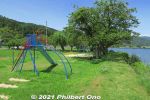
Lake Yogo playground.Mar 05, 2022
|
|

More rice paddies along Lake Yogo.Mar 05, 2022
|
|

Autumn flowers at Lake Yogo.Mar 05, 2022
|
|
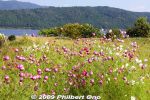
Autumn flowers at Lake Yogo.Mar 05, 2022
|
|
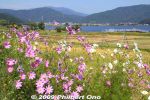
Autumn cosmos flowers at Lake Yogo.Mar 05, 2022
|
|
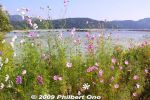
Autumn flowers at Lake Yogo.Mar 05, 2022
|
|
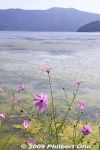
Autumn wildflowers at Lake Yogo.Mar 05, 2022
|
|
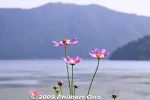
Autumn wildflowers at Lake Yogo.Mar 05, 2022
|
|
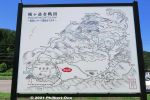
Map of Yogo area. This area is also famous for the Battle of Shizugatake in 1583.Mar 05, 2022
|
|
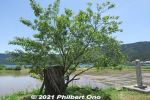
By May 2021, happy to see the swan maiden tree growing anew. Let's hope another swan maiden will now come. Although she should probably bathe with her clothes on instead. Too many perverts these days...Mar 05, 2022
|
|
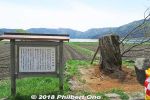
Sadly, in Oct. 2017, a major typhoon knocked down the swan maiden willow tree. Most of the tree had to be cut. This photo was taken in April 2018. 余呉湖の衣掛柳Mar 05, 2022
|
|
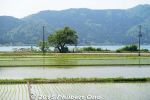
Swan maiden willow tree. Unknown how old the tree is.Mar 05, 2022
|
|
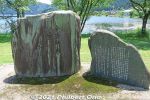
Stone monuments at Lake Yogo swan maiden monument. Looks like poetry monuments.Mar 05, 2022
|
|
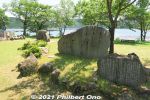
Stone monuments at Lake Yogo swan maiden monument.Mar 05, 2022
|
|
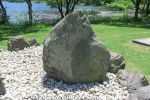
Stone monument at Lake Yogo swan maiden monument.Mar 05, 2022
|
|
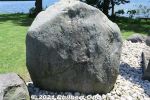
Stone monument at Lake Yogo swan maiden monument.Mar 05, 2022
|
|
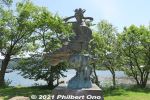
Lake Yogo swan maiden monument.Mar 05, 2022
|
|
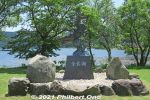
Lake Yogo swan maiden monument is flanked with a number of poetry stone monuments.Mar 05, 2022
|
|

Near the Visitors Center is the swan maiden monument.Mar 05, 2022
|
|
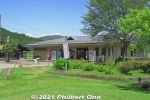
Lake Yogo Visitors Center where you can sell your catch of invasive fish. No English. There's a better tourist center on the other part of the lake.Mar 05, 2022
|
|

Fishing pier when fishing is in season (usually in winter). Like Lake Biwa, Lake Yogo is full of invasive species, especially bluegill. You can make some money by catching invasive fish and selling them to the local cooperative.Mar 05, 2022
|
|
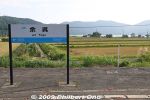
Lake Yogo in late Sept. after the rice was harvested.Mar 05, 2022
|
|
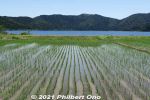
Rice paddies at Lake Yogo in late May.Mar 05, 2022
|
|

In winter, most everything is covered with deep snow.Mar 05, 2022
|
|
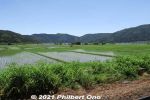
By late May, rice seedlings already planted and paddies flooded.Mar 05, 2022
|
|

From JR Yogo Station on the JR Hokuriku Line, there's a view of Lake Yogo and the rice paddies before it. This is in April when farmers are preparing the soil for rice.Mar 05, 2022
|
|
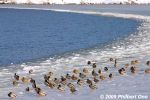
In winter, water fowl rest on the frozen lake surface.Mar 05, 2022
|
|
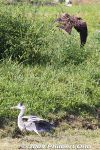
A black kite tries to steal the heron's frog.Mar 05, 2022
|
|
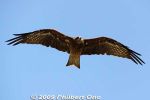
Lake Yogo's wildlife includes birds like black kites hunting for fish in the lake, mice, frogs, etc Black kites are know to swoop down and steal food from your hand. So watch out if you're eating.Mar 05, 2022
|
|
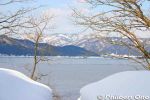
In winter, dramatic snowscapes around Lake Yogo. The Yogo area sees the most snow in Shiga. Mar 05, 2022
|
|
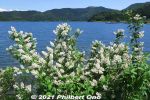
In May, these white flowers. Mar 05, 2022
|
|
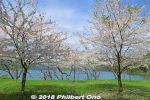
Lake Yogo is scenic in all seasons. In April, cherry blossoms bloom along a few parts of the lake.Mar 05, 2022
|
|
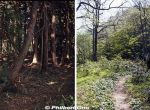
Hiking trail from Mt. Shizugatake. Heavily wooded with a few clearings.Mar 05, 2022
|
|
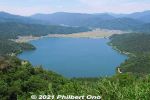
Lake Yogo as seen from Mt. Shizugatake in early June. Although it's close to Lake Biwa, it is totally separate from Lake Biwa.Mar 05, 2022
|
|
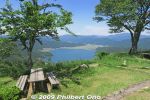
Lake Yogo is a small but scenic and serene lake north of Lake Biwa. Famous for the legend of the swan maiden. You can walk or bicycle around the lake. Near Yogo Station on the JR Hokuriku Line. Lake Yogo as seen from Mt. Shizugatake.Mar 05, 2022
|
|
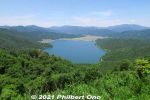
Lake Yogo as seen from Mt. Shizugatake. From Shizugatake, there are trails going down to the lake. The long trail is on the right.Mar 05, 2022
|
|
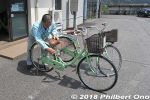
Yogo Station has rental bicycles. Great for cycling around the lake. On foot, it takes at least an hour to walk all around.Feb 24, 2022
|
|
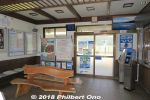
Inside JR Yogo Station.Feb 24, 2022
|
|

JR Yogo Station on the Hokuriku Line in 2018. You can rent bicycles inside the station.Feb 24, 2022
|
|
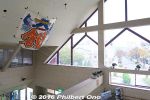
Yokaichi Station always has a large kite decoration.Feb 24, 2022
|
|
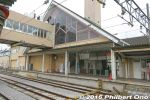
Overpass to station building.Feb 24, 2022
|
|

Rental bicycles at Shigaraki Station.Feb 24, 2022
|
|

Gift shop inside Shigaraki Station. In case you forgot buy someting for someone before you leave Shigaraki.Feb 24, 2022
|
|
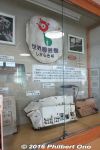
Display case in the corner shows a few pieces from the wrecked train in the 1991 accident.On the morning of May 14, 1991, a Shigaraki Kogen Railway train bound for Kibukawa collided head on with a special JR West train traveling from Kyoto to Shigaraki. It left 42 people, including five SKR employees, dead and 614 injured. Also see photos below of the monument near the accident site.Feb 24, 2022
|
|
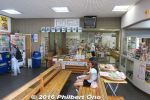
Inside Shigaraki Station waiting area. There's a display case in the corner.Feb 24, 2022
|
|
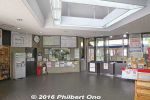
Inside Shigaraki Station.Feb 24, 2022
|
|

By now, you will notice that the tanuki (racoon dog) is the symbol of Shigaraki. This giant tanuki greets you at Shigaraki Station. Wish they removed that pay phone.Feb 24, 2022
|
|
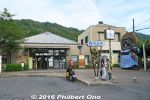
Shigaraki Kogen Railways Shigaraki Station. You can take a bus to reach Shigaraki Ceramic Cultural Park in 5 min., or walk for 20 min. 信楽駅Feb 24, 2022
|
|

Local sights.Feb 24, 2022
|
|
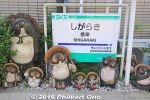
Tanuki greet you at Shigaraki Station.Feb 24, 2022
|
|

More tanuki greet you at Shigaraki Station.Feb 24, 2022
|
|

Shigaraki Kogen Railway train.Feb 24, 2022
|
|
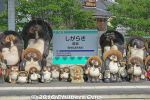
Shigaraki Station platform decorated with tanuki raccoon dogs.Feb 24, 2022
|
|
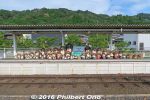
Shigaraki Station platform decorated with tanuki raccoon dogs.Feb 24, 2022
|
|

Shigaraki Station on the Shigaraki Kogen Railway Line. One-car train, diesel powered.To reach Shigaraki by train, first get on the JR Kusatsu Line, get off at Kibukawa Station where you transfer to the Shigaraki Kogen Railway Line.Feb 24, 2022
|
|
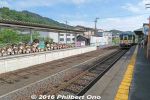
On the Shigaraki Kogen Railway Line, get off here at Shigaraki Station at the end of the line. 信楽駅 MAPFeb 24, 2022
|
|

Ninja statue in front of JR Koka Station, Shiga Prefecture.Feb 24, 2022
|
|
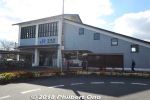
JR Koka Station on the JR Kusatsu Line opened its new station building in Nov. 2005. Resembling a farmer's warehouse on the outside, the inside has a number of surprises. MAPNorth sideFeb 24, 2022
|
|
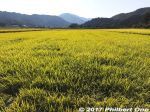
Rice field in autumn.Feb 24, 2022
|
|
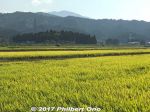
Mt. Ryosen in the distance.Feb 24, 2022
|
|
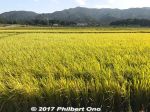
Rice fields in autumn.Feb 24, 2022
|
|
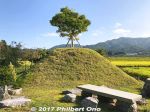
Kashiwabara-juku Ichirizuka distance marker.Feb 24, 2022
|
|
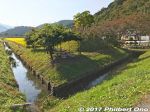
Kashiwabara Ichirizuka distance marker.Feb 24, 2022
|
|
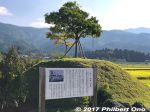
Kashiwabara Ichirizuka distance marker or milestone used by travelers to gauge how far they have traveled. This is a reconstruction in the approximate location.Feb 24, 2022
|
|
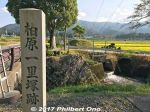
Kashiwabara Ichirizuka distance marker or milestone used by travelers to gauge how far they have traveled. Feb 24, 2022
|
|
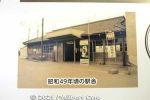
Hino Station in 1974.Jan 27, 2022
|
|

Ad for a shipping company in front of Hino Station.Jan 27, 2022
|
|

On the left are old flyers advertising local businesses in Hino while mentioning Hino Station. Lower right is a roof ornament that has the old crest of Ohmi Railways.Jan 27, 2022
|
|
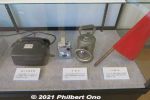
Magneto telephone with a crank (磁石式電話機), signal light, and red signal flag to signal the train.Jan 27, 2022
|
|

Implements used by Hino Station staff. Lower left is a paper ticket holder. Preprinted tickets were organized according to the destination.Jan 27, 2022
|
|

L-R: Holder for rubber date stamps used to stamp the date on the ticket. Dating machine to imprint the date on the ticket. Clippers to cutout a small square on the ticket when boarding the train. Magneto telephone with a crank.Jan 27, 2022
|
|
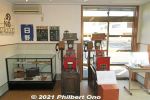
The red instruments are signalling block instruments for preventing collisions between trains. (タブレット閉塞器)Jan 27, 2022
|
|
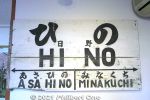
Old Hino Station signage.Jan 27, 2022
|
|
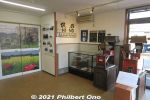
Many of the old artifacts on display can only be recognized or understood by hardcore train fans and people who worked at a train station. It's quite specialized.Jan 27, 2022
|
|

Jan 27, 2022
|
|
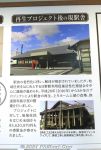
During the renovation, the entire train station building was jacked up to reinforce the foundation against earthquakes.Jan 27, 2022
|
|
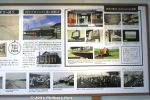
Remnants of the old days still remaining in the renovated Hino Station.Jan 27, 2022
|
|
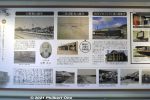
Upper left is a photo of Hino Station's opening day. The back of the station building can be seen. The building was rebuilt in 1916.Jan 27, 2022
|
|
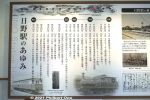
Chronology of the history of Ohmi Railways (founded in 1896) and Hino Station (first built in 1900).Jan 27, 2022
|
|

Inside Hino Station Railway Museum. History of the station on panels, and old train and station-related artifacts. No English captions.Jan 27, 2022
|
|

About the entire Hino Station being a "Railway Museum."Jan 27, 2022
|
|
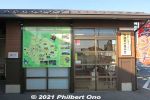
Hino Station Railway Museum. 日野駅鉄道資料展示室Jan 27, 2022
|
|

Hino Station (left) and the smaller building on the right used to be the tourist information office. It's now the Hino Station Railway Museum. 日野駅と日野駅鉄道資料展示室Jan 27, 2022
|
|
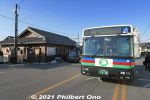
Outside the station is the bus stop for Omi-Hachiman Station.Jan 27, 2022
|
|
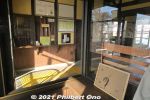
Old ticket window.Jan 27, 2022
|
|

Old ticket window and counter have been retained.Jan 27, 2022
|
|

My teishoku lunch.Jan 27, 2022
|
|
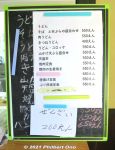
Cafe menu. Low prices. Udon, soba, and teishoku complete meals.Jan 27, 2022
|
|
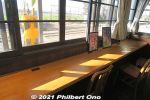
Counter seating has a view of the train platform.Jan 27, 2022
|
|
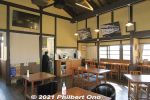
Friendly ladies wait on you for the food or drink. The clock seen on the right was actually used in the train station office.Jan 27, 2022
|
|
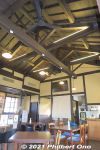
Nanairo cafe has a Western-style truss ceiling from the Taisho Period.Jan 27, 2022
|
|
|
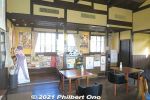
Hino Station now has a nice community space named "Nanairo" that serves as a cafe, tourist information space, and waiting room for passengers. Tourist pamphlets are on the left.Jan 27, 2022
|
|

Nanairo cafe menu.Jan 27, 2022
|
|
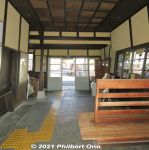
Entering the train building from the platform. Exit ahead.Jan 27, 2022
|
|
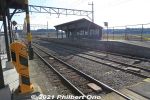
Hino Station has three sets of railway tracks, very rare. The unused middle track is vintage, made by Barrow Steel from the UK. Train platform No. 2 (for Yokaichi/Maibara) across the tracks has a roofed benches also renovated.Jan 27, 2022
|
|
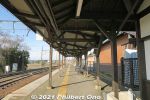
On Hino Station's train platform No. 1. Original wooden columns still usable are retained.Jan 27, 2022
|
|
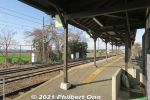
Hino Station train platform.Jan 27, 2022
|
|
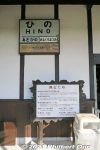
Old Hino Station sign has been in use since the Showa Period (ended in 1989). Displayed on train platform No. 1.Jan 27, 2022
|
|

Jan 27, 2022
|
|
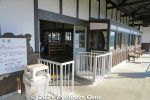
TurnstileJan 27, 2022
|
|
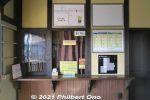
Ticket window (closed). This is new.Jan 27, 2022
|
|
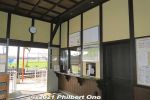
Ticket window on the right (closed).Jan 27, 2022
|
|
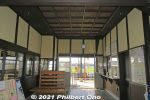
The ticket window used to be on the left corner. Now it's in the right corner. The exit goes to the train platform. The latticed ceiling came from the station's VIP room which was on the right side of the building.Jan 27, 2022
|
|
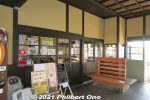
Hino Station's entrance hall. Not so many seats here, but there are benches on the platform. You can also wait inside the cafe on the left.Jan 27, 2022
|
|
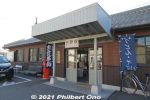
The canopy over the entrance was also renovated. It is supported by entasis columns.Jan 27, 2022
|
|
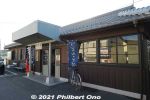
The building is now earthquake-resistant and painted dark brown. It now has a community space for a cafe, tourist information, and waiting room for passengers.Jan 27, 2022
|
|
|

Ohmi Railways Hino Station building was completey renovated in 2017. Very impressive job. Other structures were also renovated including a small railway museum. Renovations were completed by May 2020. 近江鉄道 日野駅Jan 27, 2022
|
|
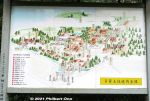
Map of Taga Taisha Shrine.Jan 26, 2022
|
|

The bean-throwers for 2021 pose for a group shot in front of Taga Taisha Shrine.Jan 26, 2022
|
|
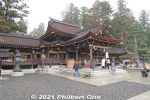
Jan 26, 2022
|
|

Setsubun beans I caught. Lots of good luck in 2021! The beans are in small paper bags. Less messy.Jan 26, 2022
|
|
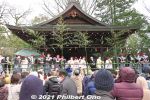
Jan 26, 2022
|
|

First the shrine priest had to shoot an arrow into the crowd, then the bean throwing began.Jan 26, 2022
|
|
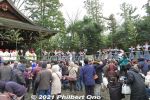
Jan 26, 2022
|
|
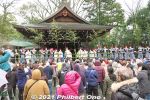
Jan 26, 2022
|
|
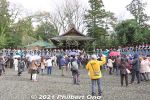
Jan 26, 2022
|
|
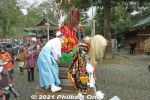
Jan 26, 2022
|
|
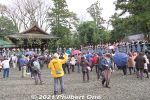
Setsubun always attracts a good crowd.Jan 26, 2022
|
|

Oni wa soto! Fuku wa uchi! (鬼は外! 福は内!)Jan 26, 2022
|
|
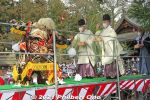
Oni wa soto! Fuku wa uchi! (鬼は外! 福は内!)Jan 26, 2022
|
|
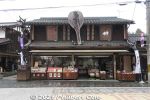
Local shop in Taga.Jan 26, 2022
|
|
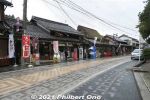
Way to Taga Taisha.Jan 26, 2022
|
|
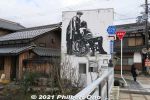
Jan 26, 2022
|
|

Torii near the train station.Jan 26, 2022
|
|
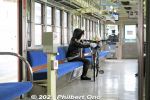
Bicycles are allowed on Ohmi Railways trains.Jan 26, 2022
|
|
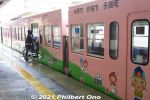
Loading a bicycle on the train.Jan 26, 2022
|
|
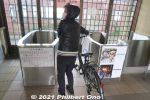
Bicycles are allowed on Ohmi Railways trains.Jan 26, 2022
|
|
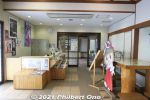
Jan 26, 2022
|
|
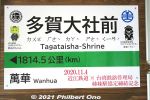
Jan 26, 2022
|
|

Jan 26, 2022
|
|
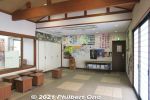
Exhibition space inside Taga Taisha-mae Station. Also good as a waiting room.Jan 26, 2022
|
|
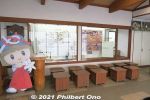
Taga Taisha-mae Station's waiting room also has a showcaseJan 26, 2022
|
|
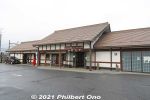
Ohmi Railways Taga Taisha-mae Station. The shrine is a 10-min. walk from this station. 近江鉄道 多賀大社前駅 MAPJan 26, 2022
|
|
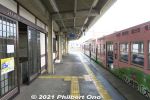
Jan 26, 2022
|
|

Mt. Ibuki and rowers in Imazu.Jan 13, 2022
|
|
|

Benzaiten-do Hall, Hogonji Temple's Hondo main hall.Jan 12, 2022
|
|
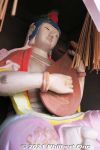
Benzaiten Goddess with her biwa lute.Jan 12, 2022
|
|
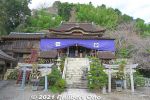
Tsukubusuma Shrine (National Treasure), Chikubushima 都久夫須麻神社Jan 12, 2022
|
|
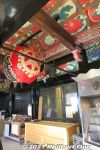
Kannon-do Hall, Hogonji Temple.Jan 12, 2022
|
|
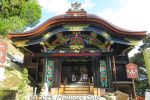
Karamon Gate, National Treasure. Renovated in March 2020.Jan 12, 2022
|
|
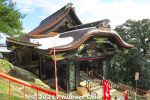
"Full of old-time stories, Chikubushima." Karamon Gate, National TreasureJan 12, 2022
|
|

Omatsukan ryokan at Omi-Maiko. This is where Oguchi Taro and rowing mates stayed when they rowed around Lake Biwa. 雄松館Jan 12, 2022
|
|
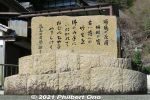
Verse 4 Song Monument, ChikubushimaAzure blue flower garden, revered coral shrine.
Full of old-time stories, Chikubushima.
In the hands of Buddha, one young maiden lies.
She's sleeping in compassion, resting peacefully.
Ruri no hanazono, sango no miya
Furui tsutae no, Chikubujima
Hotoke no mite ni, idakarete
Nemure otomego, yasurakeku
瑠璃の花園 珊瑚の宮
古い伝えの 竹生島
仏の御手に いだかれて
ねむれ乙女子 やすらけくJan 12, 2022
|
|
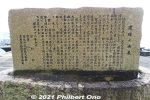
Rear of Verse 4 Song Monument, Chikubushima.It explains about the origin of the song. The monument was donated by the Biwako Kisen tour boat company which operates the boats going to the island as well as other tour boats in Lake Biwa, including the Michigan paddlewheel boat based in Otsu.Jan 12, 2022
|
|
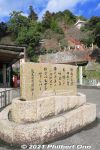
Verse 4 Song Monument, Chikubushima. Built in 1987 by Biwako Kisen, tour boat operator. 四番の歌碑。竹生島の桟橋のすぐそば。琵琶湖汽船が寄贈。The monument is right near the island's boat pier.
See more photos of Chikubushima here.Jan 12, 2022
|
|
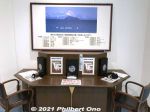
CD listening station for many cover versions by famous Japanese singers and groups. There are many, and you can listen to each of them.The song was included in a record for the first time in 1958 when Kyoto University made an album of its university songs on the 90th anniversary of the school's founding. In 1961, a chorus group named Boney Jacks recorded the song in an album of Japanese songs. And so did singer Peggy Hayama in 1962.Jan 12, 2022
|
|
|
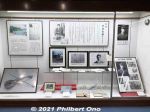
Exhibit for Oguchi Taro who composed the song.Jan 12, 2022
|
|
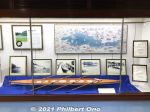
Model of fixed-seat boat used during Oguchi Taro's time in 1917.Jan 12, 2022
|
|
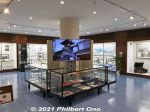
The museum has various panel exhibits, videos, etc. Currently, no explanations in English. Tokiko Kato scored a national hit with the song in 1971.Jan 12, 2022
|
|
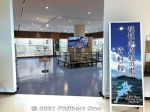
Entrance to the new Biwako Shuko no Uta Shiryokan (Lake Biwa Rowing Song Museum) in Imazu. 琵琶湖周航の歌資料館Jan 12, 2022
|
|

The museum sign includes English! Official English name is "Lake Biwa Rowing Song Museum." 琵琶湖周航の歌資料館Jan 12, 2022
|
|

Biwako Shuko no Uta Shiryokan (Lake Biwa Rowing Song Museum) moved to this building's 1st floor and opened on April 1, 2020. This is the Imazu-Higashi Community Center (今津東コミュニティセンター).Right across from the Imazu Shimin Kaikan concert hall.Jan 12, 2022
|
|
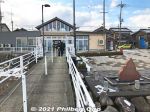
Imazu Port. The song monument is on the right. Looks like a "red fire" as mentioned in the song.From Imazu Port, you can easily go to Chikubushima island by boat, from where you can take another boat to Hikone or Nagahama. Going vice versa is possible too. It's a great way to traverse the lake.
See more photos of Imazu here.Jan 12, 2022
|
|
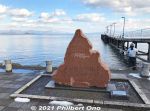
Biwako Shuko no Uta Birthplace Monument, Imazu. This is Imazu's second monument for the song. 全歌詞碑の「琵琶湖周航の歌」誕生の地 今津。今津港。背景には竹生島行きの船。Imazu has two monuments for the song. The first one is a lamp at the end of the pier (visible in this picture on the right of the boat). That was for Verse 3 which is written on the lamp post.
Later in 1994, Imazu town built this red clay monument to commemorate the song's birth in Imazu. The entire lyrics is also engraved. It is next to the Imazu boat pier where boats depart for Chikubushima. Looks like a red flame, but it's shaped after the geographical shape of Imazu town.Jan 12, 2022
|
|
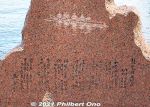
The monument is engraved with the entire song and a picture of rowers.Jan 12, 2022
|
|
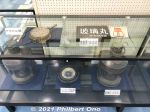
Jan 12, 2022
|
|
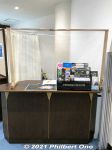
The museum is staffed by volunteers unlike the old museum which was staffed by employees from the local tourist office.Also see my blog post about the museum: https://shiga-ken.com/blog/2022/01/lake-biwa-rowing-song-museum/Jan 12, 2022
|
|

Unlike the old museum, the relocated museum does not have a gift shop. However, it does sell these stationary.Jan 12, 2022
|
|

Showcase dedicated to the works of the late song researcher Iida Tadayoshi who spent many years researching the song from the 1970s. His books and booklets about the song greatly contributed to the understanding of the song, how it was created, and the people behind it.Jan 12, 2022
|
|
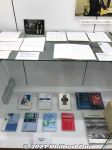
Iida donated his notebooks and cassette tapes of many interviews related to the song. Some of it is displayed here.On the lower shelf are books about the song by Iida and others.Jan 12, 2022
|
|

A few old parts from a lake cruise boat. Compass, lamp, and other things.Jan 12, 2022
|
|

Display of Biwako Shuko no Uta calendars featuring the kirie works of ??.Jan 12, 2022
|
|

Old records of the song covered by many famous Japanese singers.Jan 12, 2022
|
|
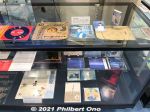
Old records of the song.Jan 12, 2022
|
|
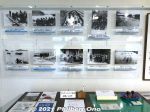
Photos of the Kanazawa college rowers who died due to strong winds that capsized their boat in 1941.Jan 12, 2022
|
|
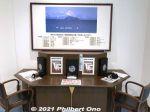
CD listening station where you can listen to numerous cover versions of the song by famous artists.Jan 12, 2022
|
|
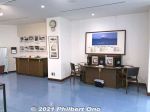
Jan 12, 2022
|
|
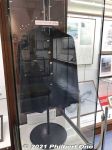
Uniform of the Dai-sanko college where Oguchi Taro studied.Jan 12, 2022
|
|
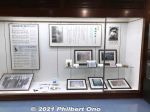
Exhibit for Yoshida Chiaki, credited for composing the original melody.Jan 12, 2022
|
|
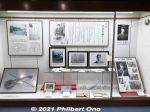
Exhibit for Oguchi Taro who composed the song.Jan 12, 2022
|
|

Song lyrics for all six verses.Jan 12, 2022
|
|
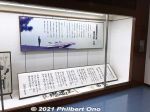
About the song lyrics.Jan 12, 2022
|
|
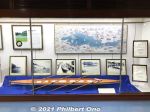
The accurate scale model of a fixed-seat boat is also displayed.Jan 12, 2022
|
|
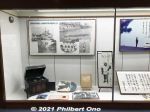
Photos of Imazu in 1917.Jan 12, 2022
|
|
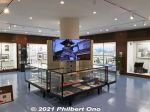
It seems all or almost all the exhibits in the old museum have been moved to this new space.Jan 12, 2022
|
|
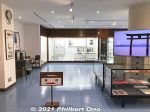
The museum has only one room in a square layout with glass cases and exhibits. The middle has a small showcase as well.Jan 12, 2022
|
|
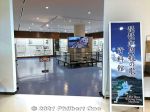
The new museum occupies a large corner of the building's first floor. It's on the left when you enter the building.Jan 12, 2022
|
|

The museum sign includes English! Official English name is "Lake Biwa Rowing Song Museum."Jan 12, 2022
|
|

The Imazu-Higashi Community Center (今津東コミュニティセンター) is across from the Imazu Shimin Kaikan concert hall. Jan 12, 2022
|
|

The new Biwako Shuko no Uta Shiryokan (Lake Biwa Rowing Song) song museum is now in this building since April 1, 2020. This is the Imazu-Higashi Community Center (今津東コミュニティセンター).Jan 12, 2022
|
|
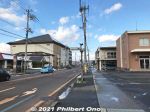
If you are walking from Omi-Imazu Station on the main road, turn left.Jan 12, 2022
|
|

If you are walking from Omi-Imazu Station, you can see this large sign on the side of the old song museum showing the way to the relocated song museum.Jan 12, 2022
|
|
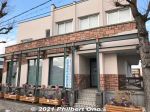
The main road also has this old Biwako Shuko no Uta Shiryokan (Lake Biwa Rowing Song) song museum which has closed. It moved to another building nearby.Jan 12, 2022
|
|
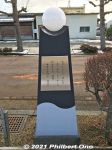
On the main road between Imazu Port and Omi-Imazu Station are sidewalk lights engraved with song lyrics. This has Verse 3 which mentions Imazu.Jan 12, 2022
|
|
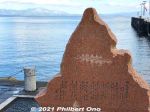
Oguchi Taro was a member of the rowing club at Dai-san High School (now Kyoto University). He composed it in Imazu, Shiga Prefecture during the second night of the trip.Jan 12, 2022
|
|
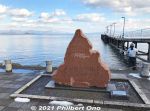
Biwako Shuko no Uta song monument at Imazu Port. In June 1917, a song called Biwako Shuko no Uta (Lake Biwa Rowing Song) was composed by college student Taro Oguchi during a boat rowing trip around Lake Biwa.Jan 12, 2022
|
|
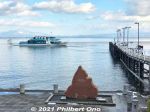
Imazu Port also has this song monument for Biwako Shuko no Uta (Lake Biwa Rowing Song). 琵琶湖周航の歌 歌碑The song is about college boys from Kyoto rowing around Lake Biwa while mentioning famous places like Otsu (the starting point), Omi-Maiko (Omatsu), Imazu, Chikubushima, Nagahama, and Chomeiji.Jan 12, 2022
|
|

The new Imazu Port, opened in March 2020. Completely rebuilt.Jan 12, 2022
|
|
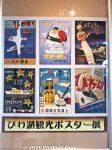
Old tourist PR posters for Lake Biwa. Great design. They don't make them like that anymore.Jan 12, 2022
|
|
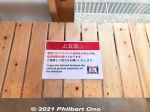
Social distancing on benches, but bad English. よい子のみなさん、この英語はダメですよ。無視してください。Jan 12, 2022
|
|
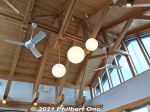
Ceiling.Jan 12, 2022
|
|
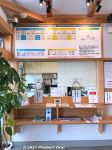
Boat ticket office operated by Biwako Kisen.Jan 12, 2022
|
|
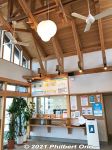
Boat ticket office.Jan 12, 2022
|
|
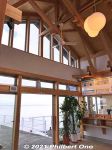
Imazu Port building is made of wood from Shiga.Jan 12, 2022
|
|
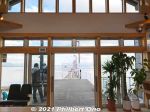
Imazu Port's gate to the boat dock.Jan 12, 2022
|
|
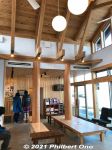
Waiting room inside Imazu Port building.Jan 12, 2022
|
|
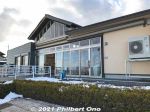
Rear view of Imazu Port building. Rebuilt and opened on March 22, 2020.Jan 12, 2022
|
|
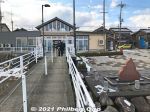
Heading to the new Imazu Port building. On the right is the Biwako Shuko no Uta (Lake Biwa Rowing Song) song monument.Jan 12, 2022
|
|
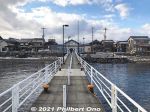
Imazu Port dock to the port building.Jan 12, 2022
|
|
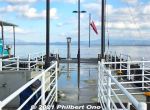
At the end of Imazu Port's dock, the lantern is a song monument for Verse 3 of Biwako Shuko no Uta (Lake Biwa Rowing Song).Jan 12, 2022
|
|
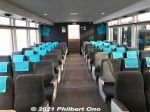
Inside Interlaken. The boat also has an outside deck.Jan 12, 2022
|
|

Inside Interlaken. Jan 12, 2022
|
|
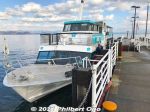
"Interlaken" cruise boat at Imazu Port.Jan 12, 2022
|
|
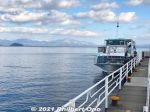
"Interlaken" cruise boat at Imazu Port with Chikubushima and Mt. Ibuki in the background.Jan 12, 2022
|
|
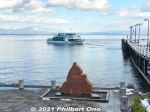
You can also get to Imazu by boat from Chikubushima island. Imazu Port has boats going to/from Chikubushima. On the eastern shore, Nagahama and Hikone have boats going to Chikubushima.At Imazu Port, boat named "Interlaken" operated by Biwako Kisen cruises to/from Chikubushima.Jan 12, 2022
|
|
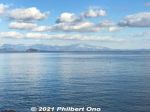
From Imazu Port, Chikubushima island and Mt. Ibuki can be seen across the lake.Jan 12, 2022
|
|
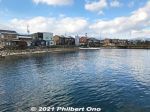
Near Imazu Port.Jan 12, 2022
|
|
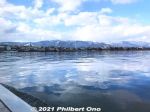
This is Imazu as the boat approaches Imazu Port. Small, quiet town anchoring the northwestern part of the lake. Tourist base for exploring this part of Shiga and the lake.Jan 12, 2022
|
|
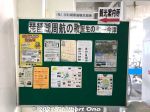
"Birthplace of Biwako Shuko no Uta" (Lake Bwa Rowing Song) on a bulletin board in the train station.Jan 12, 2022
|
|
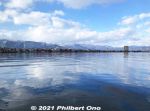
You can therefore traverse northern Lake Biwa between Nagahama/Hikone and Imazu via Chikubushima. Approaching Imazu by boat.Jan 12, 2022
|
|
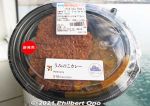
In late Jan. 2021, Uminoko Curry was sold by 7-11 only in Shiga for three weeks. It used the same recipe as the curry served on the Uminoko Floating School.Jan 11, 2022
|
|

Uminoko Curry had pork cutlet, rice, and somewhat sweet, mild curry.Jan 11, 2022
|
|

Mt. Kanakuso-dake (金糞岳 or Azai-dake) behind Takatsuki in Nagahama. The peak to the left is Shirakura-dake (白倉岳). The orange/white smokestack is from the Nippon Electric Glass factory (日本電気硝子) in Takatsuki. Jan 11, 2022
|
|

According to legend, Mt. Ibuki and Mt. Azai-dake (Kanakuso-dake) in northern Shiga argued over who was the highest in Shiga. Mt. Ibuki got so upset by the argument that he drew a sword and sliced off Azai-dake's head.The sliced-off peak fell into Lake Biwa and became Chikubushima. Read the full folktale here: https://shiga-ken.com/blog/2014/07/the-birth-of-chikubushima/Jan 11, 2022
|
|
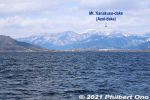
Mt. Kanakuso-dake (金糞岳 or Azai-dake) overlooks Takatsuki in Nagahama. Kanakuso-dake is indeed Shiga's second highest mountain (1,317 m). Part of Yamamoto-yama (dark green) can be seen on the left in the foreground. Jan 11, 2022
|
|

From Imazu Port, it's a short walk to JR Omi-Imazu Station to catch the JR Kosei Line (湖西線) to Kyoto.Jan 10, 2022
|
|
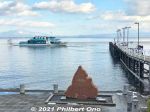
At Imazu Port is another monument for Biwako Shuko no Uta (Lake Biwa Rowing Song). Interlaken also leaves for Chikubushima.Jan 10, 2022
|
|
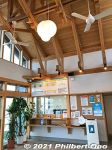
Inside the new Imazu Port building. That's the ticket office.Jan 10, 2022
|
|
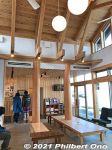
Inside the new Imazu Port building made of wood. Waiting room.Jan 10, 2022
|
|
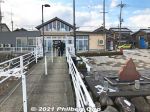
Walking to Imazu Port on the boat dock. New Imazu Port building.Jan 10, 2022
|
|
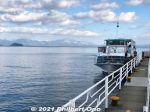
Imazu Port with Chikubushima and Mt. Ibuki in the background.Jan 10, 2022
|
|
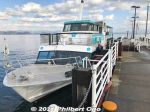
Interlaken at Imazu Port.Jan 10, 2022
|
|

Approaching Imazu in winter.Jan 10, 2022
|
|
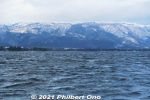
Jan 10, 2022
|
|

On the mountain top is Biwako Hakodateyama ski grounds near Imazu. びわこ箱館山Jan 10, 2022
|
|

Chikubushima's west side.Jan 10, 2022
|
|

Leaving Chikubushima.Jan 10, 2022
|
|

Jan 10, 2022
|
|

Inside the Interlaken boat. Very comfortable and looks new.Jan 10, 2022
|
|
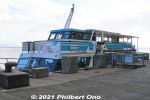
"Interlaken" boat to Imazu at Chikubushima.Jan 10, 2022
|
|
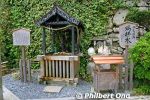
Zuisho-sui Well 瑞祥水Jan 10, 2022
|
|
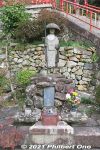
Jan 10, 2022
|
|
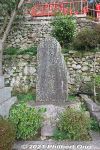
Jan 10, 2022
|
|
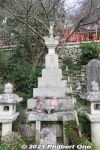
Jan 10, 2022
|
|
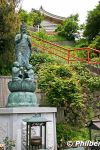
Kannon statue on Chikubushima.Jan 10, 2022
|
|
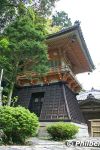
Bell towerJan 10, 2022
|
|
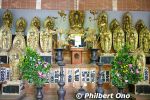
Hall of 33 Kannon Statues. 三十三所奉安所Jan 10, 2022
|
|
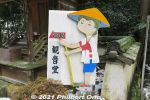
From Benten-do, way to Kannon-do (down the steps).Jan 10, 2022
|
|
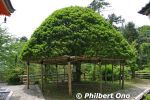
Mochinoko Tree もちの木Jan 10, 2022
|
|
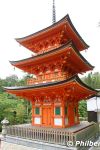
Three-Story Pagoda. Reconstructed in 2000. The original pagoda was destroyed by fire caused by lightning during the early Edo Period. It took six years to complete.Jan 10, 2022
|
|
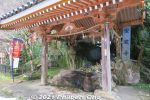
Wash basinJan 10, 2022
|
|
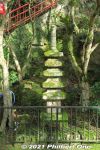
Five-story Stone Pagoda 五重石塔. Important Cultural PropertyJan 10, 2022
|
|
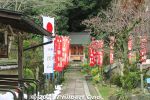
Sanryudo Shrine right next to Benzaiten-do. Worships the dragon god or the god of water. 三龍堂Jan 10, 2022
|
|
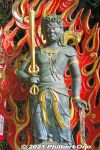
Fudō Myōō (Acala) on Chikubushima. 不動明王Jan 10, 2022
|
|
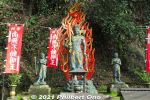
In front of Benzaiten-do is Fudō Myōō 不動明王Jan 10, 2022
|
|
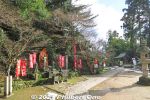
Jan 10, 2022
|
|
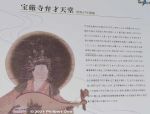
About Benzaiten-do Hall.Jan 10, 2022
|
|
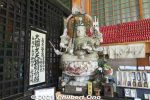
Another statue of Benzaiten.Jan 10, 2022
|
|
| 18510 files on 74 page(s) |
2 |  |
 |
 |
 |
|